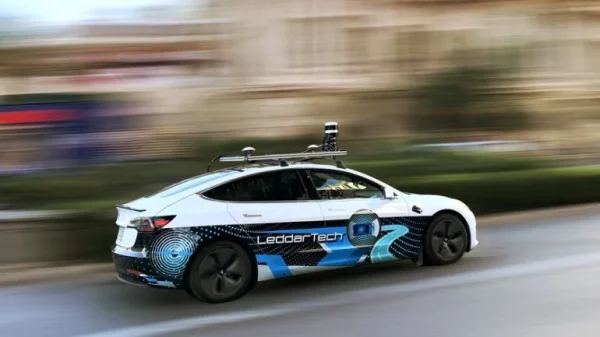Assessing the environment with AI: A solution with LeddarTech
Situational awareness when driving is critical for safer and efficient driving. How are AI based sensors assisting with this? LeddarTech develops and provides comprehensive AI-based low-level sensor fusion and perception software solutions to enable the deployment of ADAS, autonomous driving and parking applications. The software developed by the company applies advanced AI and computer vision algorithms to generate accurate 3D models of the environment to achieve better decision making and safer navigation. We spoke with Frantz Saintellemy, CEO, LeddarTech, to learn more about the company and to discuss how the company can assist the auto industry.
Frantz Saintellemy
Just Auto (JA): Can you provide some background on LeddarTech?
Frantz Saintellemy (FS): LeddarTech is a global automotive software company, that stands out with its comprehensive AI-based low-level fusion and perception software solutions. These solutions, which are crucial for deploying advanced driver assistance systems (ADAS), autonomous driving (AD), and parking applications, are developed and provided by LeddarTech.
Our automotive-grade software, powered by advanced AI and computer vision algorithms, generates accurate 3D models of the environment, enabling better decision making and safer navigation. This high-performance, scalable, and cost-effective technology is available to OEMs and Tier 1-2 suppliers, offering them an efficient way to implement automotive and off-road vehicle ADAS solutions.
LeddarTech is not just a technology provider, but a catalyst for change in the automotive industry. We are responsible for several remote-sensing innovations, with over 160 patent applications (87 granted) that enhance ADAS, AD, and parking capabilities. Our commitment to improving global mobility is unwavering. We firmly believe that better awareness around the vehicle is a key factor in making global mobility safer, more efficient, sustainable, and affordable. This belief is what drives us and shapes our technology.
What does the technology developed by LeddarTech offer the automotive industry?
Our technology delivers comprehensive end-to-end raw data fusion and perception software solutions, significantly enhancing the environmental understanding of vehicles by providing a real-time 3D view of the surroundings. This capability is crucial for making vehicles intelligent and improving safety. Our LeddarVision software is sensor-agnostic, scalable, and cost-effective, delivering highly accurate 3D environmental models for advanced driver assistance systems (ADAS) and autonomous driving (AD).
The technology enables auto manufacturers and suppliers to solve critical sensing, fusion and perception challenges
The technology enables auto manufacturers and suppliers to solve critical sensing, fusion and perception challenges and deploy higher-performance systems at much lower cost over existing solutions. LeddarVision significantly lowers cost, increases performance and shortens customers’ time-to-market through a unified software platform that leverages and improves previously trained algorithms.
The shift to software-defined vehicles will lead to positive changes in the automotive industry and provide immense business opportunities. This is especially true for automotive software companies like LeddarTech, as we pioneered AI-based low-level fusion technology.
How does this technology work?
Utilising advanced AI and computer vision algorithms, LeddarVision generates precise 3D environmental models for improved decision making and navigation safety. LeddarVision resolves many limitations of ADAS architectures based on legacy object-level fusion by providing:
Scalability to AD/HAD (automated driving/highly automated driving);
Flexible modularity to effectively handle a growing variety of use cases, features and vehicle sensor configurations;
Centralised, multi-modality (meaning multiple different kinds of sensors) sensor-agnostic low-level fusion optimally fuses all types and combinations of sensors, such as radar, sonar, camera, GPS and Lidar as needed based on the features and level of autonomy required;
Low-level sensor fusion utilises all the raw information output from each sensor without filtering at the sensor level for better and more reliable operation. As a result, this AI-based low-level sensor data fusion and perception solution provides superior performance, surpassing object-level fusion limitations in adverse scenarios like occluded objects, object separation, camera/radar false alarms, blinding light (e.g., sun, tunnel) or distance/heading estimation.
What are the ultimate benefits this technology brings?
Our mission is to improve the safety and quality of life for all travellers, commuters, workers, and mobility industry professionals by enabling applications that reduce traffic congestion, minimise the risk of road accidents, and improve the overall efficiency of road transport.
Our mission is to improve the safety and quality of life for all travellers, commuters, workers, and mobility industry professionals
Our technology enhances safety, reduces costs, and provides actionable and reliable data for ADAS and AD feature implementation at large scale for all types of vehicles. The movement toward increased adoption of ADAS and eventual AD solutions will make driving safer for everyone.
What is in the pipeline for LeddarTech this year?
We have already announced partnerships with TI, ARM, Immervision and Black Sesame, and expect to announce more in the future. We believe collaborations with world-class SoC vendors will further enhance performance and safety and accelerate OEMs time to market.
We’re experiencing strong customer momentum, while also expanding our collaborations with leading SoC providers, to accelerate the development and cadence at which we release new versions of our software. Our AI-based software continuously learns, enabling each new version to substantially outperform the last. We anticipate significant strides in achieving commercial successes and maintaining our leadership in technological readiness and intellectual property



